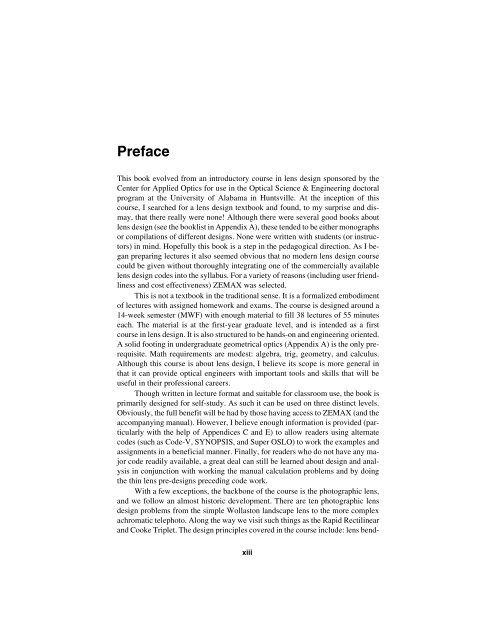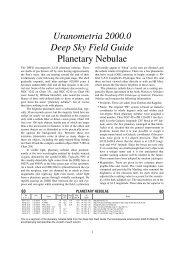Introduction to Lens Design: Preface - Willmann-Bell, Inc.
Introduction to Lens Design: Preface - Willmann-Bell, Inc.
Introduction to Lens Design: Preface - Willmann-Bell, Inc.
Create successful ePaper yourself
Turn your PDF publications into a flip-book with our unique Google optimized e-Paper software.
<strong>Preface</strong>This book evolved from an introduc<strong>to</strong>ry course in lens design sponsored by theCenter for Applied Optics for use in the Optical Science & Engineering doc<strong>to</strong>ralprogram at the University of Alabama in Huntsville. At the inception of thiscourse, I searched for a lens design textbook and found, <strong>to</strong> my surprise and dismay,that there really were none! Although there were several good books aboutlens design (see the booklist in Appendix A), these tended <strong>to</strong> be either monographsor compilations of different designs. None were written with students (or instruc<strong>to</strong>rs)in mind. Hopefully this book is a step in the pedagogical direction. As I beganpreparing lectures it also seemed obvious that no modern lens design coursecould be given without thoroughly integrating one of the commercially availablelens design codes in<strong>to</strong> the syllabus. For a variety of reasons (including user friendlinessand cost effectiveness) ZEMAX was selected.This is not a textbook in the traditional sense. It is a formalized embodimen<strong>to</strong>f lectures with assigned homework and exams. The course is designed around a14-week semester (MWF) with enough material <strong>to</strong> fill 38 lectures of 55 minuteseach. The material is at the first-year graduate level, and is intended as a firstcourse in lens design. It is also structured <strong>to</strong> be hands-on and engineering oriented.A solid footing in undergraduate geometrical optics (Appendix A) is the only prerequisite.Math requirements are modest: algebra, trig, geometry, and calculus.Although this course is about lens design, I believe its scope is more general inthat it can provide optical engineers with important <strong>to</strong>ols and skills that will beuseful in their professional careers.Though written in lecture format and suitable for classroom use, the book isprimarily designed for self-study. As such it can be used on three distinct levels.Obviously, the full benefit will be had by those having access <strong>to</strong> ZEMAX (and theaccompanying manual). However, I believe enough information is provided (particularlywith the help of Appendices C and E) <strong>to</strong> allow readers using alternatecodes (such as Code-V, SYNOPSIS, and Super OSLO) <strong>to</strong> work the examples andassignments in a beneficial manner. Finally, for readers who do not have any majorcode readily available, a great deal can still be learned about design and analysisin conjunction with working the manual calculation problems and by doingthe thin lens pre-designs preceding code work.With a few exceptions, the backbone of the course is the pho<strong>to</strong>graphic lens,and we follow an almost his<strong>to</strong>ric development. There are ten pho<strong>to</strong>graphic lensdesign problems from the simple Wollas<strong>to</strong>n landscape lens <strong>to</strong> the more complexachromatic telepho<strong>to</strong>. Along the way we visit such things as the Rapid Rectilinearand Cooke Triplet. The design principles covered in the course include: lens bend-xiii
xiv <strong>Preface</strong>ing, s<strong>to</strong>p shift, symmetry, element splitting, color correction, aberration balancing,field flattening, aspherics, as well as the proper use and construction of the meritfunction. Though ZEMAX is an integral part of the course, its use will not beblind. Manual thin lens pre-design calculations provide the starting prescriptionsfor every ZEMAX homework. Paraxial ray tracing, element power computations,and aberration calculations are utilized throughout the course. Consequently, alldesigns are firmly anchored by theory.Of equal importance <strong>to</strong> the design principles covered in the course are the analytical<strong>to</strong>ols used <strong>to</strong> determine the quality of the design. ZEMAX and its sistercodes are built upon a strong tradition of optical analysis, and will provide the userwith a rich variety of numbers and plots (such as axial color and ray fan plots, spotdiagrams, and MTF). This course will provide the student with a thorough understandingof where these numbers come from and what the plots mean. This understandingis supported by 26 assignments evenly split between “pencil and paper”calculations and ZEMAX code work. The course is structured so that studentsstart using ZEMAX in the very first week, and every week thereafter. This affectsthe arrangement of material because roughly every third lecture focuses on a specificlens design and provides background for the ZEMAX assignment.I would like <strong>to</strong> dedicate this book <strong>to</strong> Professors Roland Shack and Bob Shannonwho were my men<strong>to</strong>rs at the Optical Sciences Center. I also want <strong>to</strong> includeProf. Rudolph Kingslake in this dedication. All three have provided inspiration forthis work, and I thank each for the things I’ve learned from them.My thanks <strong>to</strong> Dr. John Dimmock, Direc<strong>to</strong>r of both the Center for AppliedOptics and the Optical Sciences and Engineering program, for his generous supportin developing the lens design course upon which this book is based. I also owea debt of gratitude <strong>to</strong> all the reviewers of the manuscript. In alphabetical order theyare: Dr. Richard Buchroeder, Dr. Qian Gong (Swales Aerospace), Dr. John Loomis(University of Day<strong>to</strong>n Research Institute), Dr. Malcolm MacFarlane (Goodrich),Mr. Ken Pitalo (University of Alabama in Huntsville), Dr. Pat Reardon(University of Alabama in Huntsville), Dr. Babak Saif (Space Telescope Institute),Dr. José Sasian (University of Arizona), Dr. Lynn Seppala (Lawrence LivermoreNational Labora<strong>to</strong>ry), Dr. Bob Shannon (University of Arizona), Dr. GregSmith, Dr. Phil Stahl (Marshall Space Flight Center), Dr. Harold Suiter, Dr. BillSwantner (BSC Optics), and Dr. Mary Turner (Focus Software <strong>Inc</strong>.). The constructivecriticism provided by these professionals has greatly improved the qualityof this work. Finally, I want <strong>to</strong> thank my daughter, Jennifer, for the fine artwork she contributed <strong>to</strong> this book.Note on ZEMAX: ZEMAX SE versions 6.0 – 7.2 have been used in the developmen<strong>to</strong>f this book and in the instruction of this course. I have found that differentversions can give slightly different numbers for variables in the lens dataedi<strong>to</strong>r and for operand values in the merit function edi<strong>to</strong>r at the end of an optimizationrun. The differences tend <strong>to</strong> be of no significance. I provide many designexamples using ZEMAX optimization where specific numerical values are pointedout or tabulated. For those using other versions of ZEMAX, please do not be
Section : xvsurprised if your post-optimization numbers do not agree precisely with mine.They should, however, be reasonably close.Instruc<strong>to</strong>r Note: I found the use of a computer projec<strong>to</strong>r absolutely indispensablein teaching this course. I strongly encourage any instruc<strong>to</strong>r <strong>to</strong> employ acomputer projec<strong>to</strong>r not only for homework reviews but also for live demonstrationsof ZEMAX features, and for illustrating design principles.Joseph M. GearyCenter for Applied OpticsUniversity of Alabama in HuntsvilleOc<strong>to</strong>ber 15, 2002
xvi <strong>Preface</strong>









